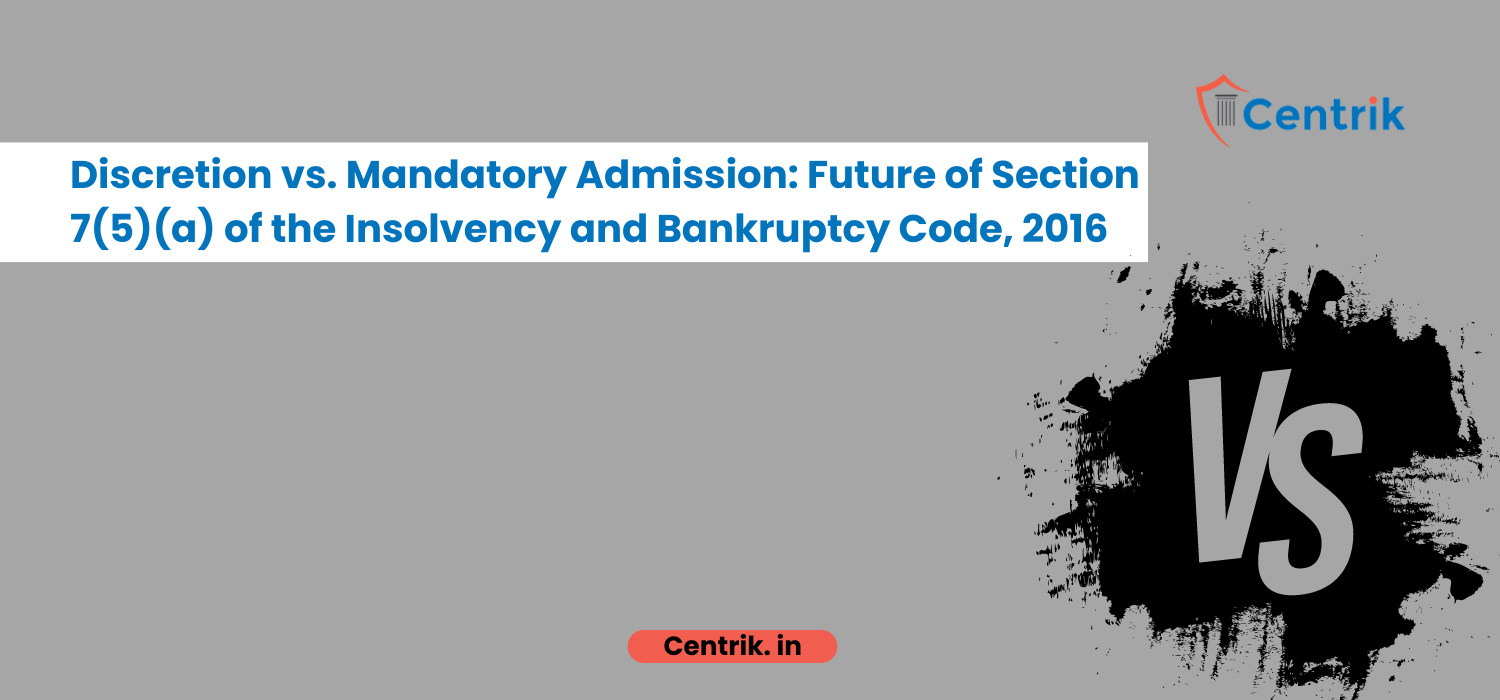When it comes to a detailed and again rather complicated legal framework of insolvency law under the Insolvency and Bankruptcy Code, 2016,(IBC) the key point is the commencement of the Corporate Insolvency Resolution Process (CIRP). This process is intended to assist firms that are in deficit and also to aid in avoiding being caught in the financial debt trap. It starts when an operational creditor which includes but is not limited to, a bank or a financial institution, in default, applies section 7(5)(a) of the IBC with the National Company Law Tribunal (NCLT).

A major question that arises is whether the NCLT possesses the discretion either to accept or reject these applications even where it is apparent that the company is in a position where it owes money (debt) and has also failed to pay the same (default) amount.
The Vidarbha Industries case was still important to the decision because the Hon’ble Supreme Court attempted to scrutinously examine the provisions of NCLT that pertain to its powers and regarding how it has to construe the law. SC also understood that Section 7(5)(a) of the IBC employs the word “may” instead of “shall” in which case, the ‘NCLT is not bound to accept every application. This ruling proved that the NCLT has the discretion i.e. to accept or reject an application for initiation of the CIRP despite the presence of evidence of debt and default. However, this power has to be exercised most cautiously by the NCLT regarding the peculiarity of each particular case.
This decision in the Vidarbha Industries case was later questioned in another case, M. Suresh Kumar Reddy v. Canara Bank. In this case, the Supreme Court agreed with the decision made in Vidarbha Industries but cautioned that it should not be seen as conflicting with earlier cases like E.S. Krishnamurthy v. Bharath Hi-Tech Builders Pvt. Ltd. The court clarified that the discretionary powers discussed in Vidarbha Industries were specific and limit to the facts of that particular case.
Insofar as it remains, the law now bears witness to the fact that the discretion has vested in the NCLT in terms of Section 7(5)(a) of IBC to accept or reject a petition for initiation of the CIRP even if there is evident existence of debt and default. Nonetheless, discretion should be exercised well taking into account the specific facts of each case. The existing issue is that by the time the Supreme Court gives its verdict on the “Maganlal Daga Huf v. Jag Mohan Daga” case there are apprehensions regarding the effect of the Vidarbha Industries on the structure of the IBC, 2016. In light of the current legal position, the law reinforces that under S. 7(5)(a) of the IBC, the NCLT bears the discretionary jurisdiction to accept or reject a petition to initiate the CIRP. Despite there is evident proof of debt and default. Nonetheless, the issue is that this discretion has to be employed diligently, especially because each case may be entirely different from the other. That being the case, there is apprehension of shifting dynamics of the larger framework of IBC, 2016 as a consequence of the ruling in Vidarbha Industries Limited case, till the resolution of the case of the “Maganlal daga Huf & Anr. V. Jag Mohan Daga”.
Later on, in “Innoventive Industries Ltd. v. ICICI Bank”, SC appreciated the fact that once debt and default have been proved, and then the process of CIRP must begin and termed it as mandatory, cementing the urgency of the process for quick disposal of insolvency cases. While making its decisions the NCLT uses several factors in the process of making the final decision and granting the desired discretion. Such factors are the ability to pay by the debtor, the existence of some real issues as to the debt, and abuse of the application process. The NCLT also tends to the interests of creditors and employees as well as to the consequences of a given decision on the industry and economy.
Thus, the NCLT’s decisions are grounded in prior court precedents and the primary objectives of the Insolvency and Bankruptcy Code [IBC]. This means that in the consideration of the case, all the provisions of the IBC must be adhered to together with the fact that the tribunal has to dispense justice based on the facts of each specific case in a manner that does not stray from the legal provisions. An instance of how this plays out is the Vidarbha Industries ruling. Coupled with such cases as “Maganlal Daga Huf v. Jag Mohan Daga”, insolvency law is always in a state of dynamics. It demonstrates how the courts must scrutinize and offer directions to how the law is applied so that it remains relevant to the current occurrences and still useful.




 join For Updates
join For Updates